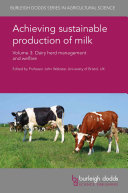

Most ebook files are in PDF format, so you can easily read them using various software such as Foxit Reader or directly on the Google Chrome browser.
Some ebook files are released by publishers in other formats such as .awz, .mobi, .epub, .fb2, etc. You may need to install specific software to read these formats on mobile/PC, such as Calibre.
Please read the tutorial at this link: https://ebookbell.com/faq
We offer FREE conversion to the popular formats you request; however, this may take some time. Therefore, right after payment, please email us, and we will try to provide the service as quickly as possible.
For some exceptional file formats or broken links (if any), please refrain from opening any disputes. Instead, email us first, and we will try to assist within a maximum of 6 hours.
EbookBell Team

4.3
78 reviewsIn meeting rising demand, more intensive dairying systems face a range of challenges such as maintaining high standards of safety in the face of the continuing threat from zoonoses entering the food chain, whilst sustaining nutritional and sensory quality. At the same time farms need to become more efficient and sustainable. Finally, farming must also meet higher standards of animal health and welfare.
Drawing on an international range of expertise, this book reviews research addressing the welfare, nutrition and health of dairy cattle. Part 1 begins by discussing key issues in welfare followed by topics such as genetic selection and welfare, housing and transportation. Part 2 looks at nutrition with chapters on rumen microbiology, feed evaluation and formulation, feed supplements and feed safety. The final part of the book covers aspects of health such as control of diseases and other disorders such as lameness as well as dairy herd health management.
Achieving sustainable production of milk Volume 3: Dairy herd management and welfare will be a standard reference for animal and dairy scientists in universities, government and other research centres and companies involved in beef production. It is accompanied by two other volumes which review milk composition, genetics and breeding as well as safety, quality and sustainability..